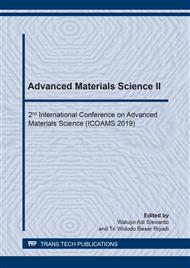[1]
X. Wang, M.C. He, J. Xie, J. Xi, X. Lu, Heavy metal pollution of the world largest antimony mine-affected agricultural soils in Hunan province (China), J. of Soil and Sediments 10 (5) (2010) 827-837.
DOI: 10.1007/s11368-010-0196-4
Google Scholar
[2]
G. Matta and L. Gjyli, Mercury, lead and arsenic: impact on environment and human health, J. of Che. and Pharm. Sci. 9 (2) (2016) 718-725.
Google Scholar
[3]
M.P. Ferraz, F.J. Monteiro, C.M. Manuel, Hydroxyapatite nanoparticles: A review of preparation methodologies, Journal of Applied Biomaterials & Biomechanics 2 (1) (2004) 74-80.
Google Scholar
[4]
A.E. Porter, N. Patel, J.N. Skepper, S.M. Best, W. Bonfield, Effect of sintered silicate-substituted hydroxyapatite on remodelling processes at the bone-implant interface, Biomaterials 25 (16) (2004) 3303-3314.
DOI: 10.1016/j.biomaterials.2003.10.006
Google Scholar
[5]
L. Tracy, J. Ridgway, J. Stuart Nelson, N. Lowe, B. Wong, alcium hydroxylapatite associated soft tissue necrosis: A case report and treatment guideline, Journal of Plastic, Reconstructive & Aesthetic Surgery 67 (4) (2014) 564-568.
DOI: 10.1016/j.bjps.2013.08.008
Google Scholar
[6]
L.H. He, O.C. Standard, T.T. Huang, B.A. Latella, M.V. Swaim, Mechanical behaviour of porous hydroxyapatite, Acta Biomater 4 (3) (2008) 577-586.
DOI: 10.1016/j.actbio.2007.11.002
Google Scholar
[7]
H. Ishizva and M. Ogino, Thin hydroxyapatite layers formed on porous titanium using electrochemical and hydrothermal reaction, J. of Mat. Sci. 31 (1996) 6279-6284.
DOI: 10.1007/bf00354450
Google Scholar
[8]
V.Q. Le, M.Q. Do,M.D. Hoang, V.T.H.Q. Pham, H.T. Nguyen, Effect of Alkaline Activators to Engineering Properties of Geopolymer-Based Materials Synthesized from Red Mud, Key Engineering Materials 777 (2018) 508-512.
DOI: 10.4028/www.scientific.net/kem.777.508
Google Scholar
[9]
Q.M. Do, T.H. Bui, H.T. Nguyen, Effects of Seawater Content in Alkaline Activators to Engineering Properties of Fly Ash-Based Geopolymer Concrete, Solid State Phenomena 296 (2019) 105-111.
DOI: 10.4028/www.scientific.net/ssp.296.105
Google Scholar
[10]
PT Kien, TTT Ly, PTL Thanh, TPQ Nguyen, NH Thang, MMAB ABDULLAH, A Novel Study on Using Vietnam Rice Hush Ash and Cullet as Environmental Materials, MATEC Web of Conferences 97 (2017) 1-6.
DOI: 10.1051/matecconf/20179701118
Google Scholar
[11]
H.T. Nguyen, V.T.H.Q. Pham, T.P. Dang, T.K. Dao, Leachability of heavy metals in geopolymer-based materials synthesized from red mud and rice husk ash, AIP Conference Proceedings 1954 (1) (2018) 040014.
DOI: 10.1063/1.5033414
Google Scholar
[12]
H.T. Nguyen, V.T.H.Q. Pham, T.N. Le, T.P. Dang, N.K.T. Nguyen, Utilization of red mud and bagasse for production of gas absorption materials, AIP Conference Proceedings 1954 (1) (2018) 040010.
Google Scholar
[13]
H.T. Nguyen, V.Q. Le, T.H. Bui, V.T.H.Q. Pham, M.Q. Do, Leaching Behavior and Immobilization of Heavy Metals in Geopolymer Synthesized from Red Mud and Fly Ash, Key Engineering Materials, 777 (2018) 518-522.
DOI: 10.4028/www.scientific.net/kem.777.518
Google Scholar
[14]
H.T. Nguyen, N.H. Nguyen, V.T.H.Q. Pham, N.K.T. Nguyen, V.T.A. Tran, T.K. Pham, Engineering properties of lightweight geopolymer synthesized from coal bottom ash and rice husk ash, AIP Conference Proceedings 1954 (1) (2018) 040009.
DOI: 10.1063/1.5033414
Google Scholar
[15]
H.T. Nguyen, Synthesis and Characteristics of Inorganic Polymer Materials Geopolymerized from Ash of Brickyard, Materials Science Forum 961 (2019) 45-50.
DOI: 10.4028/www.scientific.net/msf.961.45
Google Scholar
[16]
H.T. Nguyen, Evaluation on Formation of Aluminosilicate Network in Ternary-Blended Geopolymer Using Infrared Spectroscopy, Solid State Phenomena 296 (2019) 99-104.
DOI: 10.4028/www.scientific.net/ssp.296.99
Google Scholar
[17]
Q.M. Do, N.M. Huynh, V.U.N. Nguyen, N.T.H. Nguyen, D.T.K. Kieu, T.K. Pham, H.T. Nguyen, The Influence of Composition of Raw Materials on Formation of Phenolic Resin from Cashew Nut Shell Waste (CNSW), Defect and Diffusion Forum 394 (2019) 103-108.
DOI: 10.4028/www.scientific.net/ddf.394.103
Google Scholar
[18]
E. Katsuo, S. Malamis, M. Tzanoudaki, K.J. Haralambous, M. Loizidou, Regeneration of natural zeolite polluted by lead and zinc in wastewater treatment systems, J. of Haz. Mat. 189 (3) (2011) 773-786.
DOI: 10.1016/j.jhazmat.2010.12.061
Google Scholar
[19]
J. Acharya, J.N. Sahu, C.R. Mohanty, B.C. Meikap, Removal of lead(II) from wastewater by activated carbon developed from Tamarind wood by zinc chloride activation, Chemical engineering journal 149 (1-3) (2009) 249-262.
DOI: 10.1016/j.cej.2008.10.029
Google Scholar


